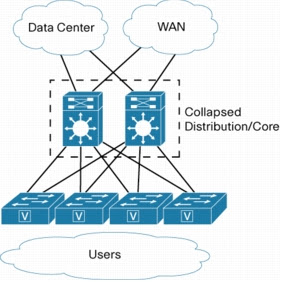Exam Essentials
Know the differences among leased lines, circuit switching, and packet switching. A leased
line is a dedicated connection, a circuit switched connection is like a phone call and can be on
or off, and packet switching is essentially a connection that looks like a leased line but is priced
more like a circuit-switched connection.
Understand the different WAN protocols. Pay particular attention to HDLC, Frame Relay,
and PPP. HDLC is the default encapsulation on
Cisco routers, PPP provides an industry-standard
way of encapsulating multiple routed protocols across a link and must be used when connecting
equipment from multiple vendors. Frame relay is a packet-switched technology that can offer cost
advantages over leased lines but has more complex configuration options.
 |
| Exam Essentials Questions and Answers |
Review Questions
1. Which of the following allows a router to respond to an ARP request that is intended for a
remote host?
A. Gateway DP
B. Reverse ARP (RARP)
C. Proxy ARP
D. Inverse ARP (IARP)
E. Address Resolution Protocol (ARP)
2. You want to implement a mechanism that automates the IP configuration, including IP
address, subnet mask, default gateway, and DNS information. Which protocol will you use
to accomplish this?
A. SMTP
B. SNMP
C. DHCP
D. ARP
3. Which class of IP address provides a maximum of only 254 host addresses per network ID?
A. Class A
B. Class B
C. Class C
D. Class D
E. Class E
4. Which of the following describe the DHCP Discover message? (Choose two.)
A. It uses FF:FF:FF:FF:FF:FF as a layer 2 broadcast.
B. It uses UDP as the Transport layer protocol.
C. It uses TCP as the Transport layer protocol.
D. It does not use a layer 2 destination address.
5. What are two charcterisitics of Telnet (choose 2)?
A. It send data in clear text format
B. It is a protocol designed and used only by Cisco routers
C. It is more secure then using Secure Shell (SSH)
D. You must purchase Telnet from Microsoft
E. It requires the destiatnion device be confiugre to support Telnet services and connections
6. Which of the following services use UDP? (Choose three.)
A. DHCP
B. SMTP
C. SNMP
D. FTP
E. HTTP
F. TFTP
7. Which of the following are TCP/IP protocols used at the Application layer of the OSI model?
(Choose three.)
A. IP
B. TCP
C. Telnet
D. FTP
E. TFTP
8. When data is encapsulated, which is the correct order?
A. Data, frame, packet, segment, bit
B. Segment, data, packet, frame, bit
C. Data, segment, packet, frame, bit
D. Data, segment, frame, packet, bit
9. Which two statements about a reliable connection-oriented data transfer are true?
A. Receiving hosts acknowledge receipt of data.
B. When buffers are full, packets are discarded and are not retransmitted.
C. Windowing is used to provide flow control and unacknowledged data segments.[
D. If the transmitting host’s timer expires before receipt of an acknowledgment, the transmitting
host drops the virtual circuit.
10. Which of the following describe router functions? (Choose four.)
A. Packet switching
B. Collision prevention
C. Packet filtering
D. Broadcast domain enlargement
E. Internetwork communication
F. Broadcast forwarding
G. Path selection
Answers to Review Questions
1. C. Proxy ARP can help machines on a subnet reach remote subnets without configuring
routing or a default gateway.
2. C. Dynamic Host Configuration Protocol (DHCP) is used to provide IP information to hosts
on your network. DHCP can provide a lot of information, but the most common is IP address,
subnet mask, default gateway, and DNS information.
3. C. A Class C network address has only 8 bits for defining hosts: 28 – 2 = 254.
4. A, B. A client that sends out a DHCP Discover message in order to receive an IP address
sends out a broadcast at both layer 2 and layer 3. The layer 2 broadcast is all Fs in hex, or
FF:FF:FF:FF:FF:FF. The layer 3 broadcast is 255.255.255.255, which means all networks and
all hosts. DHCP is connectionless, which means it uses User Datagram Protocol (UDP) at the
Transport layer, also called the Host-to-Host layer.
5. A, E. Telnet has been around as long as networking and there is no cost to implement Telnet
services on your network. However, all data is sent in a clear text format and both the sending
and receving devices must have telnet services running.
6. A, C, F. DHCP, SNMP, and TFTP use UDP. SMTP, FTP, and HTTP use TCP.
7. C, D, E. Telnet, File Transfer Protocol (FTP), and Trivial FTP (TFTP) are all Application layer
protocols. IP is a Network layer protocol. Transmission Control Protocol (TCP) is a Transport
layer protocol.
8. C. The encapsulation method is data, segment, packet, frame, bit.
9. A, C. When a virtual circuit is created, windowing is used for flow control and acknowledgment
of data.
10. A, C, E, G. Routers provide packet switching, packet filtering, internetwork communication,
and path selection.











.png)






.jpg)


